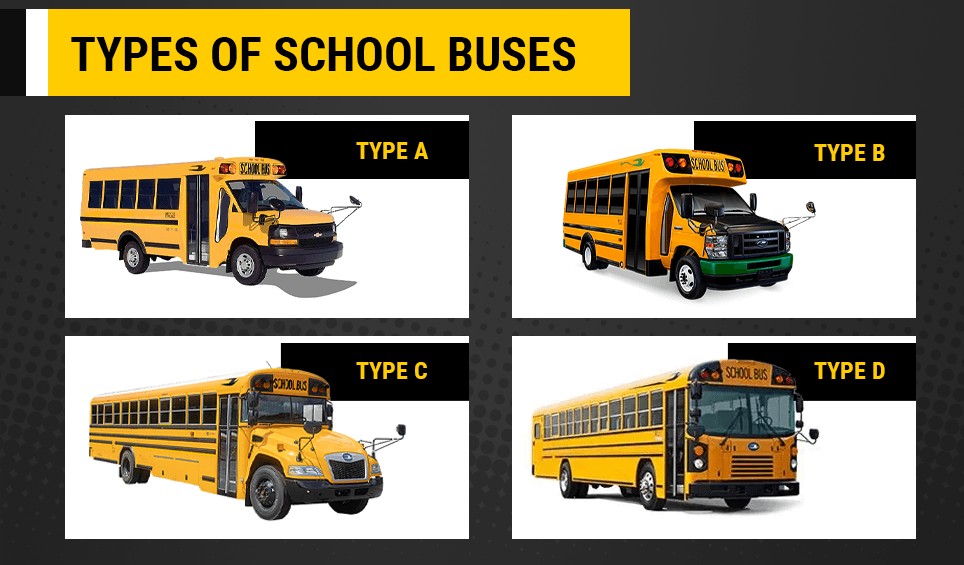School buses are essential for student transportation, and with increasing demand, understanding the costs involved in purchasing one is crucial. The cost of a bus isn’t just a simple figure; it depends on several factors. Whether you’re looking at new or used buses, knowing these factors will help you make an informed decision.
Types of School Buses and Their Impact on Cost
There are four main types of school buses, each designed for specific needs and impacting the overall cost.
 Types of School Buses: Type A, Type B, Type C, and Type D
Types of School Buses: Type A, Type B, Type C, and Type D
Type A Buses
Type A buses are built on a van chassis and are the smallest type of school bus. They are ideal for smaller groups and routes in congested areas. Their compact size often translates to a lower price point compared to larger buses.
Type B Buses
Type B buses resemble Type A buses but have a larger body. They offer more capacity and are often used for special needs transportation. The increased size and specialized features can influence their cost.
Type C Buses
Type C buses are the classic, iconic yellow school buses with a distinct hood. They are versatile and suitable for various routes. Their size and capabilities make them a mid-range option in terms of cost.
Type D Buses
Type D buses, also known as rear-engine buses, have their engine in the back for a quieter ride and better visibility. These are the largest type of school bus, designed for heavy-duty routes and large student groups, making them the most expensive option.
New vs. Used School Buses: A Cost Comparison
As with any vehicle, the price of a school bus significantly differs between new and used models.
New School Buses
New school buses come with the latest technology and safety features but also a higher price tag. Electric school buses (ESBs), driven by environmental concerns and programs like the EPA’s Clean School Bus Program, can range from $250,000 for a Type A to $440,000 for a Type C or D. In contrast, diesel versions cost approximately $90,000 to $95,000 for Type A and $140,000 to $160,000 for larger Type C or D buses. While the initial cost of an ESB is higher, potential long-term savings exist through reduced maintenance.
Used School Buses
The price of a used school bus depends on its condition, mileage, and age. A used bus with 80,000 to 180,000 miles may cost between $3,000 and $10,000, with prices varying based on condition. Purchasing a used bus can significantly reduce upfront costs, but it’s crucial to factor in potential repair and maintenance expenses.
The Impact of Size on Bus Cost
The size of the school bus directly correlates with its passenger capacity and overall cost.
- Passenger Capacity: Type A and B buses have capacities ranging from 10-30 and 10-45 passengers, respectively, while Type C and D buses can accommodate 54-90 and 72-90 passengers. The more passengers a bus can carry, the higher its cost.
- Length: Longer buses require more materials and manufacturing, resulting in higher prices. However, their increased capacity can lead to cost savings per student in the long run.
How Energy Source Affects Bus Pricing
The energy source powering a school bus significantly impacts its price, as well as ongoing operational costs.
Diesel Buses
Diesel buses are a popular choice, with prices ranging from $140,000 to $160,000. They offer a balance of performance and cost-effectiveness but may incur higher fuel and maintenance costs over time.
Electric Buses
Electric school buses (ESBs) are more expensive upfront, ranging from $250,000 to $440,000. However, they offer lower operating costs and environmental benefits, potentially making them a cost-effective choice in the long term.
Propane Buses
Propane buses offer a cleaner alternative to diesel at a competitive price. While initial costs may be similar to diesel buses, propane offers lower and more stable fuel prices, and they can offer better lifetime costs when considering the vehicle lifespan.
Compressed Natural Gas (CNG) Buses
CNG buses are another eco-friendly option with higher initial costs than diesel buses, ranging from $25,000 to $30,000 on average. The savings come from lower maintenance and fuel costs and predictable fuel costs.
Upkeep and Maintenance: The Hidden Costs of Bus Ownership
Beyond the initial purchase price, upkeep and maintenance costs are crucial considerations. These include fuel, repairs, and regular maintenance, which can vary based on bus type and energy source. Electric and propane buses generally have lower maintenance costs than diesel buses.
To reduce maintenance expenses, school districts can:
- Keep Fewer Backup Buses: Reducing the number of backup buses can lower overall maintenance costs.
- Optimize Routes: Efficient routes minimize distance traveled and the number of stops, saving on fuel and maintenance.
- Strategically Buying Fuel: Purchasing fuel when prices are low can lead to significant savings.
- Enforcing Safe Driving: Training drivers on safe driving practices can reduce accidents and associated repair costs.
Making an Informed Decision on How Much a Bus Costs
Determining how much a bus costs involves evaluating various factors, from bus type and size to energy source and maintenance requirements. By considering these elements, you can make an informed decision that aligns with your budget and transportation needs. Remember to factor in the long-term operational costs and environmental impact when choosing the right school bus for your district.
